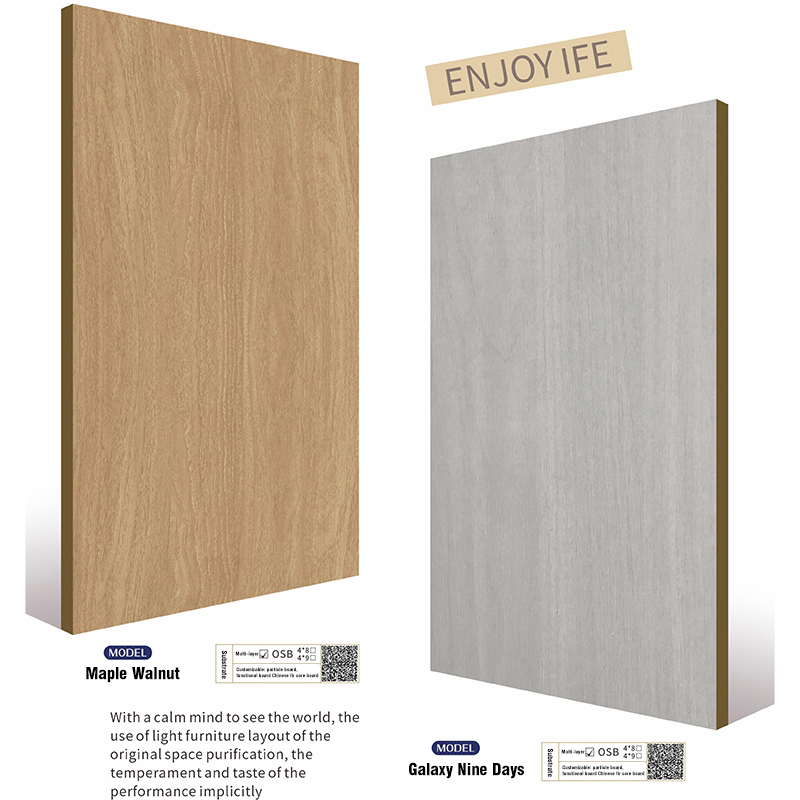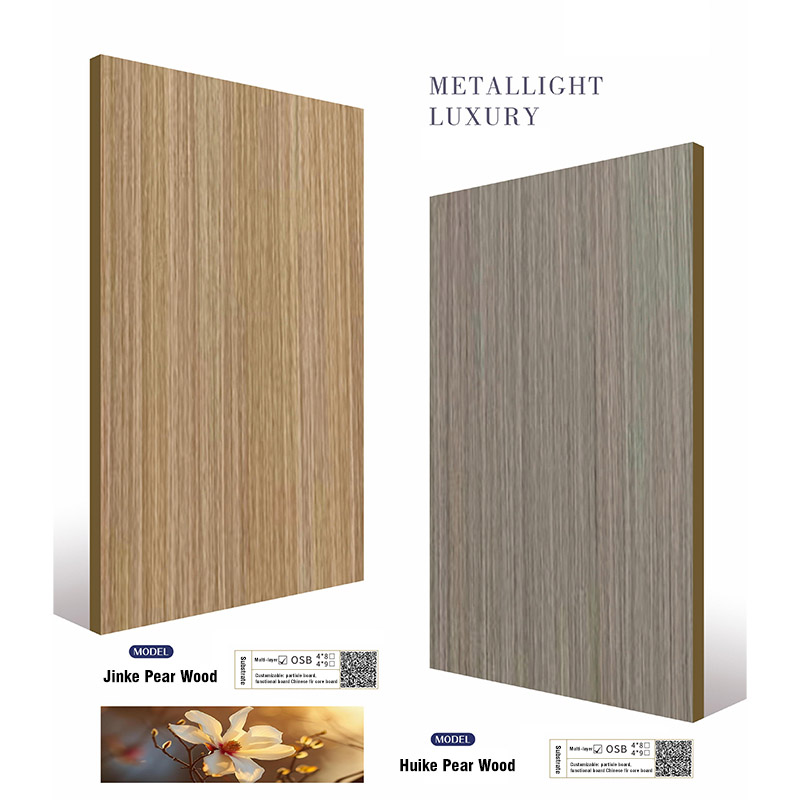How does Cuban rubberwood/semi-light wood grain board substrate perform in terms of stability and resistance to deformation?
Release Time : 2025-09-23
In modern interior design and furniture manufacturing, the choice of substrate directly determines the quality, durability, and overall performance of the finished product. Among the wide variety of available panels, Cuban rubberwood/semi-light wood grain board substrate is increasingly becoming the preferred material for high-end custom projects due to its unique natural properties and processing advantages. Its superior stability and dimensional stability compared to ordinary engineered wood panels are particularly noteworthy. This advantage stems not from complex chemical treatments or artificial reinforcement, but from the inherent structural characteristics of the wood itself and the scientific processing techniques used.
Ordinary engineered wood panels, such as particleboard, medium-density fiberboard (MDF), or plywood, are made from wood chips, sawdust, or short fibers, bonded together with adhesives under high temperature and pressure. During production, these panels undergo significant physical restructuring, disrupting the original fiber orientation and structure of the wood, leading to uneven internal stress distribution. Under fluctuating temperature and humidity conditions, these panels are prone to warping, cracking, or edge chipping due to moisture absorption and expansion or contraction. This is especially problematic in humid areas or environments with frequent temperature changes, where cabinets or walls made from ordinary engineered wood often exhibit door warping, misalignment of joints, and other issues, affecting aesthetics and functionality.
Cuban rubberwood, on the other hand, is a natural hardwood with a long growth cycle, a dense structure, and uniformly arranged fibers. The wood has excellent longitudinal fiber continuity, forming a natural tensile and compressive strength framework. This original fiber structure is preserved in the finished panel, resulting in greater overall integrity and inherent stability. Even with fluctuating humidity, the wood exhibits only minimal expansion and contraction, with deformation occurring more uniformly, minimizing localized warping or structural damage caused by stress concentration.
Furthermore, after harvesting, rubberwood undergoes rigorous drying. This process is not merely about removing moisture; it involves controlled kiln drying to match the moisture content of the wood to the intended use environment. This ensures that the internal stress within the wood is balanced, significantly reducing the risk of deformation due to moisture migration during subsequent processing and use. In contrast, some ordinary engineered wood panels, in pursuit of higher production efficiency, often have insufficient drying time or inadequate quality control, resulting in residual internal stress that continues to release even after leaving the factory, leading to potential deformation issues.
In terms of structure, panels made with rubberwood as the core material typically use a multi-layered, cross-laminated bonding process, creating a structure similar to solid wood composite panels. The surface layer is a select, semi-gloss wood veneer, while the core layers are made of multiple layers of rubberwood veneer, cross-laminated and hot-pressed. This structure effectively counteracts the deformation tendencies caused by the anisotropy of wood—longitudinal expansion is restrained by the transverse layers, and transverse shrinkage is restrained by the longitudinal layers, keeping overall deformation to a minimum. Ordinary engineered wood panels, however, are typically made with fibers oriented in one direction, lacking this self-balancing mechanism, and are more prone to warping in a single direction.
The surface treatment further enhances stability. The semi-gloss wood veneer not only imparts a warm, natural aesthetic, but its coating also provides a certain level of sealing, slowing down the penetration of moisture into the core material. The soft, matte finish minimizes glare from reflected light and reduces the visibility of fingerprints and scratches. This combination of a stable core and a durable surface finish allows the panel to maintain its natural beauty while offering greater environmental adaptability.
Its performance during installation and use also demonstrates its superiority. The rubberwood core provides strong nail-holding power, ensuring that fasteners remain secure; the panel edges are robust, resisting chipping or cracking after routing or drilling; and large panels for walls or doors maintain flatness even after long-term use. Even in large-span structures, sagging or twisting is minimized.
Ultimately, the stability of the rubberwood/semi-gloss wood grain board substrate is the result of the synergy between natural materials and modern technology. It doesn't rely on thick coatings or metal frames to resist deformation, but rather leverages the inherent structural properties of wood, fully realizing its potential through scientific processing. When a panel remains flat and stable over time, it transcends the realm of mere decorative material, becoming a silent yet reliable foundation for a space, embodying a profound pursuit of quality and durability.
Ordinary engineered wood panels, such as particleboard, medium-density fiberboard (MDF), or plywood, are made from wood chips, sawdust, or short fibers, bonded together with adhesives under high temperature and pressure. During production, these panels undergo significant physical restructuring, disrupting the original fiber orientation and structure of the wood, leading to uneven internal stress distribution. Under fluctuating temperature and humidity conditions, these panels are prone to warping, cracking, or edge chipping due to moisture absorption and expansion or contraction. This is especially problematic in humid areas or environments with frequent temperature changes, where cabinets or walls made from ordinary engineered wood often exhibit door warping, misalignment of joints, and other issues, affecting aesthetics and functionality.
Cuban rubberwood, on the other hand, is a natural hardwood with a long growth cycle, a dense structure, and uniformly arranged fibers. The wood has excellent longitudinal fiber continuity, forming a natural tensile and compressive strength framework. This original fiber structure is preserved in the finished panel, resulting in greater overall integrity and inherent stability. Even with fluctuating humidity, the wood exhibits only minimal expansion and contraction, with deformation occurring more uniformly, minimizing localized warping or structural damage caused by stress concentration.
Furthermore, after harvesting, rubberwood undergoes rigorous drying. This process is not merely about removing moisture; it involves controlled kiln drying to match the moisture content of the wood to the intended use environment. This ensures that the internal stress within the wood is balanced, significantly reducing the risk of deformation due to moisture migration during subsequent processing and use. In contrast, some ordinary engineered wood panels, in pursuit of higher production efficiency, often have insufficient drying time or inadequate quality control, resulting in residual internal stress that continues to release even after leaving the factory, leading to potential deformation issues.
In terms of structure, panels made with rubberwood as the core material typically use a multi-layered, cross-laminated bonding process, creating a structure similar to solid wood composite panels. The surface layer is a select, semi-gloss wood veneer, while the core layers are made of multiple layers of rubberwood veneer, cross-laminated and hot-pressed. This structure effectively counteracts the deformation tendencies caused by the anisotropy of wood—longitudinal expansion is restrained by the transverse layers, and transverse shrinkage is restrained by the longitudinal layers, keeping overall deformation to a minimum. Ordinary engineered wood panels, however, are typically made with fibers oriented in one direction, lacking this self-balancing mechanism, and are more prone to warping in a single direction.
The surface treatment further enhances stability. The semi-gloss wood veneer not only imparts a warm, natural aesthetic, but its coating also provides a certain level of sealing, slowing down the penetration of moisture into the core material. The soft, matte finish minimizes glare from reflected light and reduces the visibility of fingerprints and scratches. This combination of a stable core and a durable surface finish allows the panel to maintain its natural beauty while offering greater environmental adaptability.
Its performance during installation and use also demonstrates its superiority. The rubberwood core provides strong nail-holding power, ensuring that fasteners remain secure; the panel edges are robust, resisting chipping or cracking after routing or drilling; and large panels for walls or doors maintain flatness even after long-term use. Even in large-span structures, sagging or twisting is minimized.
Ultimately, the stability of the rubberwood/semi-gloss wood grain board substrate is the result of the synergy between natural materials and modern technology. It doesn't rely on thick coatings or metal frames to resist deformation, but rather leverages the inherent structural properties of wood, fully realizing its potential through scientific processing. When a panel remains flat and stable over time, it transcends the realm of mere decorative material, becoming a silent yet reliable foundation for a space, embodying a profound pursuit of quality and durability.







